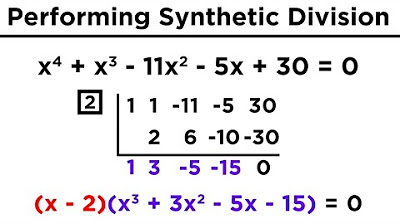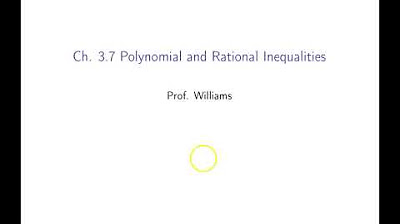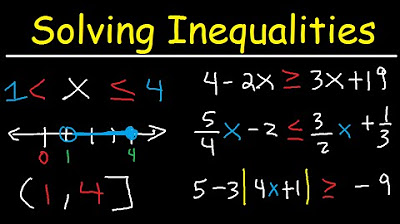Solving Polynomial Inequalities
TLDRThis lesson focuses on solving polynomial inequalities. It explains how to solve inequalities by factoring, creating number lines, and testing intervals. The instructor demonstrates examples, starting with quadratic inequalities and moving to higher-degree polynomials, showing step-by-step how to manipulate and solve these inequalities. Key points include moving terms to one side, factoring, determining points of interest, using number lines to test regions, and expressing solutions in interval notation and inequality form. The lesson concludes with the application of synthetic division and the rational zero theorem to solve more complex polynomial inequalities.
Takeaways
- 🔢 Solving polynomial inequalities involves finding a range of answers rather than a specific answer, unlike equations.
- ➡️ The first step is to move all terms to one side, resulting in a quadratic inequality.
- 🧮 Factor the polynomial to identify critical points on a number line.
- 📉 Identify the points where the polynomial equals zero, marking them as open or closed circles based on the inequality symbol.
- 🔎 Test the intervals between critical points to determine where the polynomial is positive or negative.
- 📏 The solution consists of intervals where the polynomial's product is positive (or negative, depending on the inequality).
- 📐 Use interval notation or inequalities to express the final solution.
- 📊 Factor by grouping or using the rational zero theorem for higher-degree polynomials to find critical points.
- 🔄 Remember to test intervals between critical points and alternate signs if the multiplicity of a root is odd.
- 📝 Express the solution using both interval notation and inequalities to cover all possible forms of the answer.
Q & A
What is the first step in solving the polynomial inequality x^2 + 3x > 10?
-The first step is to move the 10 to the other side to set the inequality to zero, resulting in x^2 + 3x - 10 > 0.
How do you factor the quadratic expression x^2 + 3x - 10?
-You factor it by finding two numbers that multiply to -10 and add to 3, which are 5 and -2. Thus, the factors are (x + 5)(x - 2).
What are the points of interest for the inequality (x + 5)(x - 2) > 0?
-The points of interest are x = -5 and x = 2 because these values make the expression equal to zero.
Why are open circles used at x = -5 and x = 2 on the number line?
-Open circles are used because the inequality is greater than zero, not greater than or equal to zero, so the points themselves are not included.
How do you determine which regions on the number line satisfy the inequality (x + 5)(x - 2) > 0?
-You test points in each region: between negative infinity and -5, between -5 and 2, and between 2 and infinity, to see if the product of (x + 5) and (x - 2) is positive.
What is the solution to the inequality (x + 5)(x - 2) > 0 using interval notation?
-The solution is (-∞, -5) ∪ (2, ∞).
How can the solution to (x + 5)(x - 2) > 0 be expressed using inequalities?
-The solution can be expressed as x < -5 or x > 2.
What is the standard form of the inequality x^3 - x < 3x^2 - 3?
-The standard form is x^3 - 3x^2 - x + 3 < 0.
How do you factor the polynomial x^3 - 3x^2 - x + 3?
-You factor it by grouping: x^2(x - 3) - 1(x - 3), resulting in (x - 3)(x^2 - 1). Then, further factor x^2 - 1 as (x + 1)(x - 1), so the complete factorization is (x - 3)(x + 1)(x - 1).
How do you determine the solution to the inequality (x - 3)(x + 1)(x - 1) ≤ 0 using a number line?
-You test the signs in each region determined by the points of interest x = -1, x = 1, and x = 3, using closed circles since the inequality includes zero. You find which regions make the product non-positive.
What is the solution to (x - 3)(x + 1)(x - 1) ≤ 0 using interval notation?
-The solution is [-1, 1] ∪ [3, ∞).
How can the solution to (x - 3)(x + 1)(x - 1) ≤ 0 be expressed using inequalities?
-The solution can be expressed as -1 ≤ x ≤ 1 or x ≥ 3.
What is the next step after factoring the polynomial x^3 - 2x^2 > 5x - 6?
-You move everything to one side to set the inequality to zero, resulting in x^3 - 2x^2 - 5x + 6 > 0.
How do you find the rational zeros of the polynomial x^3 - 2x^2 - 5x + 6?
-You use the Rational Zero Theorem to test possible rational zeros, such as ±1, ±2, ±3, and ±6, until you find a zero.
What is the complete factorization of x^3 - 2x^2 - 5x + 6?
-The complete factorization is (x - 1)(x + 2)(x - 3).
What are the points of interest for the inequality (x - 1)(x + 2)(x - 3) ≥ 0?
-The points of interest are x = -2, x = 1, and x = 3.
How do you determine which regions on the number line satisfy the inequality (x - 1)(x + 2)(x - 3) ≥ 0?
-You test points in each region to see if the product is non-negative, considering that the inequality includes zero, so use closed circles at the points of interest.
What is the solution to the inequality (x - 1)(x + 2)(x - 3) ≥ 0 using interval notation?
-The solution is [-2, 1] ∪ [3, ∞).
How can the solution to (x - 1)(x + 2)(x - 3) ≥ 0 be expressed using inequalities?
-The solution can be expressed as -2 ≤ x ≤ 1 or x ≥ 3.
Outlines
📐 Resolviendo desigualdades polinómicas
En esta lección, se explica cómo resolver desigualdades polinómicas, comenzando con un ejemplo de x² + 3x > 10. Se detalla el proceso de mover el 10 al otro lado, factorizar la expresión y usar una línea numérica para encontrar las soluciones. Se discuten los puntos de interés y cómo determinar las regiones positivas y negativas. La solución se expresa tanto en notación de intervalo como en desigualdades.
📝 Ejemplo de desigualdad polinómica compleja
El segundo ejemplo aborda la desigualdad x³ - x < 3x² - 3. Se muestra cómo mover todos los términos al lado izquierdo y reordenarlos en forma estándar. Luego se factoriza usando agrupación y la diferencia de cuadrados perfectos. Se dibuja una línea numérica para identificar los puntos de interés y se determinan las regiones donde la expresión es negativa. La solución se da en notación de intervalo y como desigualdades.
🔍 Resolviendo otra desigualdad polinómica
El último ejemplo presenta la desigualdad x³ - 2x² ≥ 5x - 6. Se mueve todo al lado izquierdo y se usa el teorema del cero racional para encontrar las raíces. Se emplea la división sintética y se factoriza completamente la expresión. Se identifican los puntos de interés en una línea numérica y se determinan las áreas positivas y negativas. La solución se proporciona en notación de intervalo y como desigualdades.
Mindmap
Keywords
💡Polynomial Inequalities
💡Quadratic Inequality
💡Factoring
💡Number Line
💡Interval Notation
💡Critical Points
💡Rational Zero Theorem
💡Synthetic Division
💡Difference of Perfect Squares
💡Multiplicity
💡Inequality Solutions
Highlights
Introduction to solving polynomial inequalities with an example.
Moving constants to the other side to form a quadratic inequality.
Factoring the quadratic expression to find the roots.
Using a number line to identify points of interest and regions.
Determining the sign of the expression in different regions.
Selecting test points to determine the sign of the product in each region.
Expressing the solution using interval notation and inequalities.
Solving a cubic polynomial inequality by moving terms.
Factoring by grouping to simplify the inequality.
Identifying the points of interest using the factored form.
Including points of interest in the solution with closed circles.
Testing the sign of the expression in different intervals.
Alternating signs due to the multiplicities of each zero.
Describing the solution using inequalities and interval notation.
Using the rational zero theorem to find possible rational zeros.
Applying synthetic division to find additional zeros.
Factoring the expression completely after finding all zeros.
Determining the regions where the expression is positive or negative.
Expressing the final solution with interval notation and inequalities.
Transcripts
Browse More Related Video

Solving and Graphing Polynomial and Rational Inequalities

Rational Inequalities

Solving Higher-Degree Polynomials by Synthetic Division and the Rational Roots Test

Ch. 3.7 Polynomial and Rational Inequalities

Solving Inequalities Interval Notation, Number Line, Absolute Value, Fractions & Variables - Algebra

Solving Quadratic Inequalities (Precalculus - College Algebra 25)
5.0 / 5 (0 votes)
Thanks for rating: